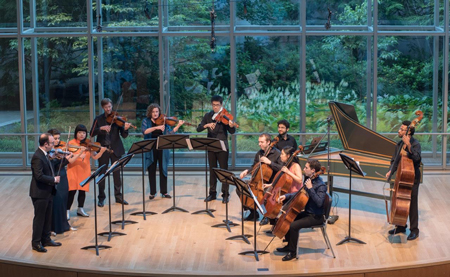by Timothy Robson

The concert showed off the qualities we have come to expect from ChamberFest: brilliantly imaginative programming, with a mix of old, new, familiar, and unfamiliar works, in superior performances by (mostly young) musicians hand-picked by festival directors Franklin and Diana Cohen.
J.S. Bach’s Brandenburg Concerto No. 3, scored for 3 violins, 3 violas, 3 cellos, double bass, and harpsichord, opened the concert. The performance was characterized by tight ensemble and crisp tempi. Played on modern instruments, the work’s dynamics were broader than they might have been with period instruments, but the musicians showed recognition of historically informed performance practice.
Bach did not compose a second movement, only a final cadence, so performers are left to devise their own solution. For this performance, harpsichordist Roman Rabinovich improvised a short cadenza on a descending bass line, and the ensemble joined for the cadential chords. The ensemble played the third movement, Allegro, at a breakneck speed, tossing off Bach’s dialogue of traded musical phrases with aplomb.

The ensemble difficulties are fearsome — the pianists play almost non-stop and at all dynamic levels, from ethereal passages to pounded, bell-like chiming. Playing with flash, Rabinovich appeared more fluent in Adams’ style, while Žlabys seemed to be working harder. But this is tough music, period, and the outcome was thrilling. There was a spontaneous cheer from the audience at the end, even before the applause began.

After a disquieting, slow introduction, the first movement progresses to a stormy Allegro, with crashing piano chords and furious string writing. At its center, a long pianissimo cello note melts into a lyrical passage, before the Allegro returns. After all the drama, the movement ends quietly on a dry pizzicato note. The Adagio second movement begins as a string chorale, and the piano enters quietly, leading into music of rapturous lyricism, the cello featuring prominently in several solo passages. The closing Allegro returns to musical material from the first movement, this time more playful.
Violinists Yura Lee and Diana Cohen, violist Zhanbo Zheng, cellist Oliver Herbert, and hardworking pianist Roman Rabinovich (in his third outing of the evening) were first-rate and gave Elgar’s Quintet a persuasive reading, alert to each other, bending phrases and rhythms to bring out the inner workings of the music.
Photos by Gary Adams.
Published on ClevelandClassical.com June 19, 2017.
Click here for a printable copy of this article



